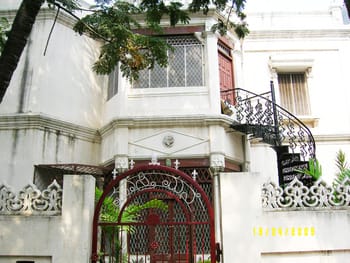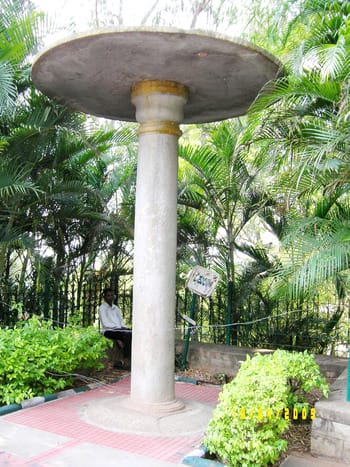On 18th April 2009, World Heritage Day, Bangalore City projects – a Bengaluru based group that aims to raise awareness about arts and culture in the city, organised some events, one of which was a heritage hunt. Conducted in three places, this hunt was aimed at throwing light on places of heritage in and around one’s neighbourhood. I took part in the Gavipuram vernacular heritage hunt.
The teams gathered at Basavangudi Bull Temple around 3 PM. Very soon, the quiet temple premises were filled with fervour and talk as the teams registered at Rs 50 per person. We were all given a map, which had some clues. The aim of the hunt was to find six places of historical or cultural importance in and around Basavanagudi. The team which solved all the clues, found the places and returned first would be declared the winner. The hunt was supposed to be done on foot, but this rule had its set of flouters!
The first heritage hub clue that a friend and I figured out together was MVJK Trust. Just around the corner from Bull Temple, MVJK Trust was Dr. Maasti Venkatesh Iyengar’s home. Popularly referred to as Maasti Kannadada Aasti, he was a well-known Kannada writer and recipient of the Jnanpith Award. The street where his residence is situated is also named after him.

Dr. Maasti Venkatesh Iyengar’s house (Pic: Deepthi Sharma)
His house was typical of old south Indian homes. The red oxide flooring and the ambience of the place jettisoned the hurry of the hunt from our minds and we decided to take a peek inside. Dr. Iyengar had started a monthly magazine in 1944 called Jeevana. We found these magazines at his house.

A monthly magazine edited and Published by Dr. Maasti Venkatesh Iyengar (Pic: Deepthi Sharma)
Having found MVJK Trust ahead of the other teams, we set out in pursuit of our next clue in high spirits. This led us to a stone parasol, usually associated with temples, situated in a park. This park was an old hillock and is famously known as Hariharagutta but is now called Thimmesh Prabhu Park. The monolith, situated to the right hand side of this temple dedicated to Shiva and Vishnu, is featured in many 18th century paintings and drawings. More information on this is provided in the book Deccan Traverses, which travels the extraordinary landscape of Bengaluru.

Monolithic stone parasol associated with shiva vishnu temple (Pic: Deepthi Sharma)
The park had a temple within it. With great enthusiasm, we started searching for clues within the park, much to the curiosity of the strollers and to the amusement of a few taking an afternoon nap. Heritage hunt teams with maps in their hands could easily pass off as a survey team! The green surroundings of the park brought some relief from the intense heat of a summer afternoon. The park, and the locality itself, had its share of Nandi figures scattered at different locations.

Nandi idol (Pic: Deepthi Sharma)
The next clue read: This structure is one of the four such well known ones in four corners of Bangalore. One in Lalbagh, one at Ulsoor Lake, one near Mekhri Circle and the fourth here. This particular one is located on the banks of an ancient tank called…..
There was only one tank nearby and that was Kempambudhi Tank. After asking a few people around, we reached the tank and a park associated with it from the farther end. Having wasted a lot of time searching for the tank, we finally came to the end of the park and discovered the famous structure. There was a sense of jubilation.
It is believed that Kempe Gowda built several tanks and ponds in and around the city to provide continuous water supply to his subjects. Rapid urbanisation and mismanagement have led to the disappearance of these tanks, one by one. This tank is an ideal example of the fact that during those days, tanks were not just water resources but were the centers for religious, cultural and sporting activities. (reason not given for this statement)
Close to this structure is another ancient temple of the area, dedicated to Veerabhadra.
The following inscription was found under the Kempe Gowda tower near the tank – ‘This is one of the four famous watch towers said to have been built by the famous Kempe Gowda of Magadi (1521-1569) and marks the limit to which it was predicted that the town of Bangalore would extend’.

Kempambudhi Tank (Pic: Deepthi Sharma)

Ancient temple of Veerabhadra (Pic: Deepthi Sharma)
The next heritage hub nearby, was a state award winning institute, founded in 1965, and dedicated to the promotion and development of literature, culture and social service. Called Udayabhanu Kalasangha, it was named after the rising sun in Kannada. It was interesting to find that across this road is an ancient street lined with choultries and marriage halls. The Ramakrishna Ashram located on Bull Temple Road and the Sringeri Peetha Matha are some of the spiritual places one could visit in this area

Udayabhanu kalasangha (Pic: Deepthi Sharma)
By this time our focus was fading as the heat took over our skills of reading the map or solving clues. Despite our flagging energy, it was surprising to see so many places of historical importance in a radius of about three kilometres. We were now heading to another famous temple in this locality which has given its name to the area – Gavipura.

Gavi Gangadhareshwara Temple entrance (Pic: Deepthi Sharma)
The famous Gavi Gangadhareshwara Temple has a fascinating history. The site of the temple is also known as Gouthama Kshethra as it is believed that sage Gouthama and Bharadwaja used to meditate here. At the entrance of the temple premises, one is immediately drawn to four monolithic stone sculptures – a damaru (drum), a trishul (trident), suryapana (translation) and chandrapana (translation). Unfortunately the temple was closed and so we could only see it from the outside.

Monolithic stone sculptures of Gavi Gangadhareshwara Temple (Pic: Deepthi Sharma)
The almost two and a half hour walk in the area gave us a good feel of the place. Many temples and marriage halls, chaotic main roads filled with modern shopping amenities but the side roads and by lanes still reflecting the city of yester years. Showing the growing city and the mix of people that lived here. The significant developments which were brought about by the then kings and rulers are still being used to some extent. It was indeed pleasant to see the contrast of the modern city mixed with its heritage.
With this thought we came to the place where we began the hunt, the famous Bull Temple, which marked the last heritage hub.

Bull temple entrance (Pic: Deepthi Sharma)
This temple is said to have been constructed about 500 years ago. The nandi (bull) in the temple is a sculptural masterpiece. It is said that a nandi appeared in the dream of Kempe Gowda, the ruler who laid the foundation for the city, and requested that a temple be built on the hill. At the foot of the hill is a temple for Dodda Ganapathy. There is a temple for Lord Siva a little above the Ganesha temple. Legend has it that the river Vishva Bharti originates at the base of the nandi idol. Every year, around November, a famous fair called Kadlekaye Parishey is held along the street in front of the temple, when the first groundnut harvest of the season is offered to nandi.
Basavangudi houses numerous old and beautiful temples, esteemed institutions, busy marketplaces, parks, lakes and malls. Earlier, this neighbourhood was home to scholarly Brahmin families. It had roads lined with shady trees and huge mansions and European styled bungalows, many of which have given way to urbanisation and apartment complexes. It is disheartening to see that today some roads here are lined with garbage. There are small and scattered slum dwellings as well.
We completed the hunt, with the satisfaction of having found all the places but with a little bit of disappointment at not having won. But we also appreciated this innovative way of spreading awareness about the beautiful places that our city has. The surprise coupons to Cane-o-La, the sugarcane juice shop, brought a sweet and refreshing end to this rather tiring but very enjoyable and informative heritage hunt. ⊕
Nice read. We live close by and I will certainly try to find some of landmarks mentioned here that we have not seen. btw, Is the picture of the Veerabhadhra Temple, from the Bugle Rock Park? I was not aware it was called that.
Good one. Liked the pictures. Thanks Deepti.